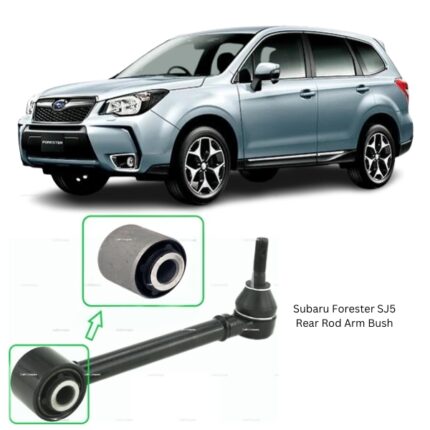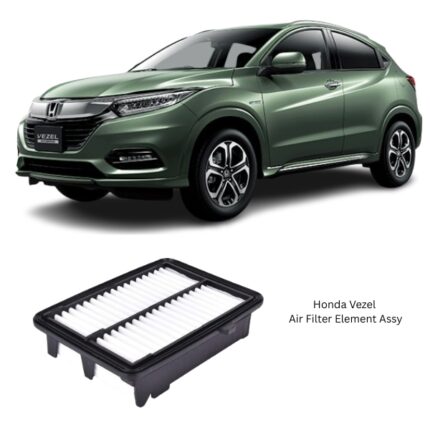Get Honda Vezel Front Shock Absorber Assy 3340143 in Kenya
The front shock absorber assembly is a key component of the suspension system that directly affects a vehicle’s handling, stability, ride comfort, and overall safety. It is engineered to manage the movement of the front wheels, reduce vibrations from the road, and maintain continuous contact between the tires and the ground. Whether navigating smooth highways or rough terrain, the front shock absorber plays a vital role in ensuring a controlled, comfortable, and safe driving experience.
Understanding its purpose, construction, working principle, signs of wear, and maintenance requirements is essential for proper vehicle operation and component longevity.
Function of the Front Shock Absorber Assembly
The primary function of a front shock absorber is to control and dampen the oscillations of the vehicle’s suspension system. When the vehicle travels over uneven surfaces such as potholes, speed bumps, or rough roads, the suspension system compresses and rebounds. Without a shock absorber, this movement would continue uncontrollably, leading to excessive bouncing and a loss of stability.
The front shock absorber manages this motion by converting kinetic energy (movement) into thermal energy (heat), which is then dissipated through hydraulic fluid or pressurized gas. By absorbing and dissipating this energy, the assembly prevents the vehicle from bouncing excessively and ensures the tires remain in contact with the road.
This constant control enhances various aspects of driving:
-
Improved steering responsiveness
-
Reduced braking distances
-
Enhanced cornering stability
-
Minimized body roll and pitch
-
Increased passenger comfort
-
Extended lifespan of other suspension components
Components of a Front Shock Absorber Assembly
A complete front shock absorber assembly may vary depending on suspension design, but commonly includes the following:
-
Shock Absorber (Damper): The core part that contains the piston, hydraulic fluid, or gas.
-
Strut or Coil Spring Seat: In MacPherson strut designs, the spring seat supports the vehicle’s weight via a coil spring.
-
Upper Mount or Strut Mount: Connects the assembly to the vehicle’s chassis and includes a bearing for steering movement.
-
Dust Boot and Bump Stop: The dust boot protects the piston rod from debris, while the bump stop prevents over-compression.
-
Spring (in strut-type assemblies): Supports vehicle weight and absorbs vertical loads.
-
Mounting Hardware: Bolts, washers, and bushings used for installation.
Each of these components is designed to work in harmony to deliver consistent and reliable suspension performance.
Types of Front Shock Absorbers
There are several types of front shock absorber assemblies based on the suspension system used:
-
MacPherson Strut Assembly: Integrates the shock absorber with the coil spring into a single unit. It also serves as a structural component, supporting the vehicle’s weight and enabling steering movement.
-
Shock-and-Spring Assembly (Non-Strut): In systems with double wishbone or multi-link suspension, the shock absorber operates independently of the spring. Both components are mounted separately but function cooperatively.
-
Mono-Tube Shock Absorber: Features a single tube with a floating piston separating the gas and oil chambers. Offers better cooling and consistent performance.
-
Twin-Tube Shock Absorber: Consists of an inner and outer tube, with hydraulic fluid moving between them. It is more common in standard passenger vehicles.
Each design is tailored to different vehicle types and performance expectations, from everyday commuting to heavy-duty or performance driving.
How It Works
Inside the shock absorber is a piston that moves through hydraulic fluid or a gas-charged chamber. As the suspension moves up and down, the piston compresses the fluid, which flows through calibrated valves. This creates resistance that slows down the movement.
The shock absorber is engineered to respond differently to compression and rebound:
-
Compression Stroke: When the wheel moves upward, the shock compresses and resists motion to absorb impact.
-
Rebound Stroke: As the suspension returns to its normal position, the shock controls the speed of this return to prevent bouncing.
This dual-action control is critical in maintaining balance, comfort, and road grip.
Importance of a Functional Front Shock Absorber
The front shock absorber assembly is essential for more than just comfort. Its condition directly influences:
-
Braking Safety: By keeping the tires in contact with the road, the shock absorber allows the braking system to perform efficiently and evenly.
-
Steering Precision: A stable suspension system improves steering responsiveness and control, especially during turns or sudden maneuvers.
-
Tire Wear: Proper damping reduces uneven tire wear and prolongs tire life.
-
Suspension Protection: Absorbs shock loads that would otherwise stress other components such as control arms, bushings, and ball joints.
-
Vehicle Stability: Reduces the risk of body roll, nose-diving during braking, and rear squat during acceleration.
Because the front of the vehicle bears more weight and is responsible for steering and braking dynamics, the performance of front shocks is especially critical.
Signs of a Worn Front Shock Absorber
Over time, shock absorbers wear out due to constant motion, exposure to the elements, and fluid breakdown. Recognizing the symptoms of a failing shock absorber can prevent unsafe driving conditions:
-
Excessive Bouncing: The vehicle continues to bounce after hitting a bump.
-
Nose-Diving During Braking: The front of the vehicle dips noticeably when brakes are applied.
-
Poor Steering Response: Loose or delayed steering feel, especially at higher speeds or over uneven surfaces.
-
Leaking Hydraulic Fluid: Visible oil around the shock body indicates a breach in the seal.
-
Uneven or Rapid Tire Wear: Caused by improper damping leading to inconsistent tire-to-road contact.
-
Clunking or Knocking Sounds: Noise from the suspension area when driving over bumps, indicating possible wear or damage.
-
Vehicle Pulling or Instability: Shock absorbers failing to keep the wheels planted may result in a drifting sensation during driving.
Ignoring these symptoms can lead to increased repair costs and a compromised safety profile.
When to Replace a Front Shock Absorber Assembly
While shock absorbers do not have a fixed replacement interval, it is generally recommended to inspect them every 50,000 to 80,000 kilometers. Replacement should be based on usage conditions and performance:
-
Frequent driving on rough or unpaved roads
-
Towing or carrying heavy loads
-
Aggressive or high-speed driving
-
Older vehicles or high-mileage use
Always replace shock absorbers in pairs (both front units) to maintain suspension symmetry and consistent handling.
Maintenance Tips
Though shock absorbers are largely maintenance-free, certain practices help extend their lifespan:
-
Perform regular visual inspections for fluid leaks or damage.
-
Replace worn suspension components promptly to avoid excess stress on the shocks.
-
Keep tires properly inflated and aligned to reduce suspension strain.
-
Listen for unusual noises from the front suspension and address them early.
Proper maintenance not only ensures safety but also preserves overall ride quality.
Follow us on Facebook for more parts.





Reviews
Clear filtersThere are no reviews yet.